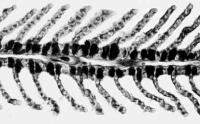A little about fish, physiology, and what we do:
Explore the links below to learn more about topics related to our work.
Smolt Biology
One of the most well-known characteristics of Atlantic salmon is their migratory life cycle which takes them from freshwater streams to the ocean, eventually to return to as adults to spawn in the place where they were born. This strategy, known as anadromy, places complicated challenges on fishes as they move between wholly different aquatic environments. Click here for a brief description of the anadromous physiology of Atlantic salmon.

